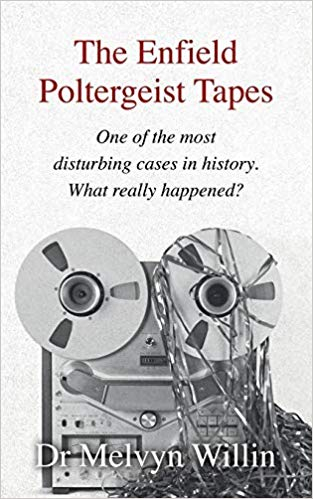
Reviewed by Nemo C. Mörck
The Enfield Poltergeist Tapes is Dr Melvyn Willin’s fifth book. It is a small, but certainly an interesting, book (180 pages including appendixes, a suggested reading list, and an index). The title refers to the tape recordings made by Maurice Grosse (1919-2006) and Guy Lyon Playfair (1935-2018) during their investigation of the well-known Enfield poltergeist case, to which Playfair devoted a book: This House is Haunted, first published by Souvenir Press in 1980. A third edition was published by White Crow Books in 2011. Willin has not only listened to all tapes, he has also transcribed and digitized them. This was made possible thanks to Jason Engwer and the Survival Research Fund.
This kind of case is messy, with claims and counterclaims. One wishes that the Enfield poltergeist case had been written up for an issue of the Proceedings of the SPR at the time, but Playfair wrote a book. The SPR did however decide to create an Enfield Poltergeist Investigation Committee whose report on the case Willin summarizes. The report is available at the SPR library, but not online. The Enfield Poltergeist Tapes should be regarded as a companion to This House is Haunted. It includes statements of several psychical researchers, including stalwarts of the SPR like Mary Rose Barrington and Alan Gauld. In addition to coverage of the Enfield case the book includes a chapter on the case that inspired the novel, and later the film, The Exorcist (see Rueda, 2018; Personally, I think this is redundant and would have preferred Willin to include more information from sources that are not easily accessible).
Many readers are aware of the typical poltergeist phenomena – the Enfield case included all, and more besides. One of the early incidents: “… Mr Richardson came to see what was going on … two marbles flew past him at terrific speed and slammed into the bathroom door at the end of the passage. He picked them up and found they were burning hot” (Playfair, 2011, p. 6). Later, Grosse saw: “The heavy green sofa rose about four feet in the air, flipped over backwards and crashed upside down on the floor” (Playfair, 2011, pp. 73-74). In addition to this kind of phenomena the case included apparitions, objects that disappeared and reappeared, automatic drawing, possible possession, metal-bending, and even allegedly levitations. However, Playfair and Grosse never saw any apparitions or levitations. Willin has usefully summarized the case in the Psi Encyclopedia.
A man who thought that he had witnessed one of the children, Janet, levitating told Grosse:
The whole episode was very violent and I was very upset and disturbed by what I saw. Very soon after the episode I was outside the house talking to someone about these strange events when Janet came out. She looked very vacant and certainly not like a child who had just been playing about (p. 44)
Another of the three witnesses refused to talk about what she thought that she had seen.
Among the most controversial phenomena were certainly the gruff voices - allegedly, spirits spoke through the children, in particular Janet. However, the spirits claiming different identities, including a previous occupant, did not really provide anything evidential; instead investigators had to listen to nonsense. Understandably, many concluded that the voices were faked. Concerning Janet, Playfair noted: “There have been several occasions when she says something it obviously meant to say, and vice versa. Would she slip up like that if she was faking the whole thing?” (Playfair, 2011, p. 162). Attempts were made to get the voices to speak when Janet’s mouth was taped shut or when she held water in her mouth – most results appear to have been inconclusive. However, Hugh Pincott (at the time Honorary Secretary of the SPR) reports that once the voice “continued to speak with undiminished clarity” (p. 122). According to David Robertson, who at the time was working with John Hasted known for his research on metal-bending, a session was even filmed: “I operated the camera and recorded it talking despite her closed lips, tape and water in the mouth” (p. 139). Nevertheless, Willin remarks that in addition to the voice laughter is also often heard on the tapes, occasionally the girls (Janet and Margaret) also complained about having sore throats. The adults were not naïve and were understandably irritated now and then when they thought that the girls had faked phenomena. Grosse believed that just five percent of the phenomena were faked.
Willin notes that “Grosse believed passionately in the veracity of the phenomena that he witnessed at Enfield and, at times, he was angered by the disbelief of those who disagreed with him ...” (p. 99). I think it is fair to say that this is equally true for Playfair. Grosse and Playfair presented the results of their investigation at a conference organized by the SPR in 1978. Gauld recalls: “The resultant disputes outlasted the conference for months, or indeed years, and became, at times, somewhat acrimonious as people, both within and outside the SPR took sides” (p. 129). Notable among the sceptical psychical researchers were Tony Cornell and Anita Gregory. The trouble with the fraud hypothesis in this case is that things were reported to happen even when the children were not around, and it must be admitted that it is hard to conceive how some phenomena were faked. Willin has attempted to let the facts speak for themselves, and the book ends with a Discussion rather than a Conclusion. The Enfield Poltergeist Tapes is a book that I can recommend to anyone interested in poltergeist phenomena.
References
Playfair, G. L. (2011). This House is Haunted (3rd Ed.). Guildford: White Crow Books.
Rueda, S. A. (2018). Diabolical Possession and the Case Behind The Exorcist. Jefferson, NC:
McFarland.

